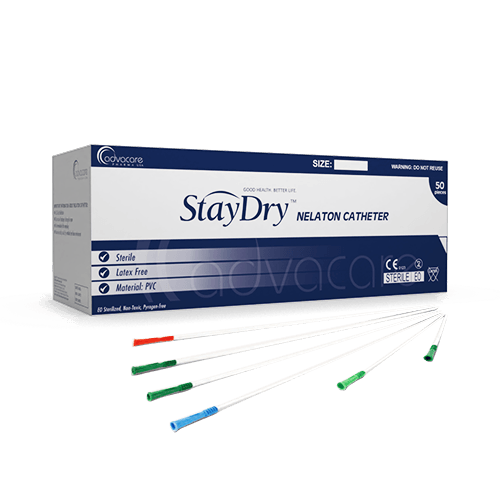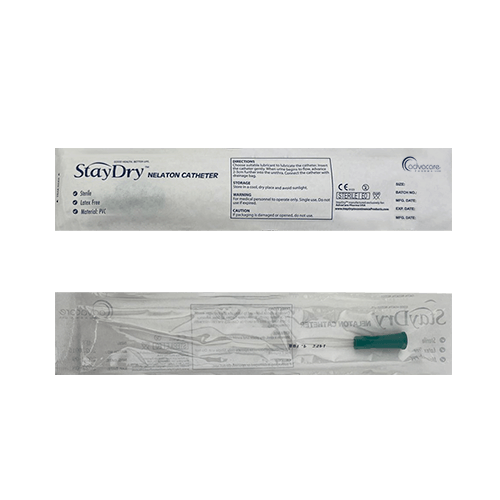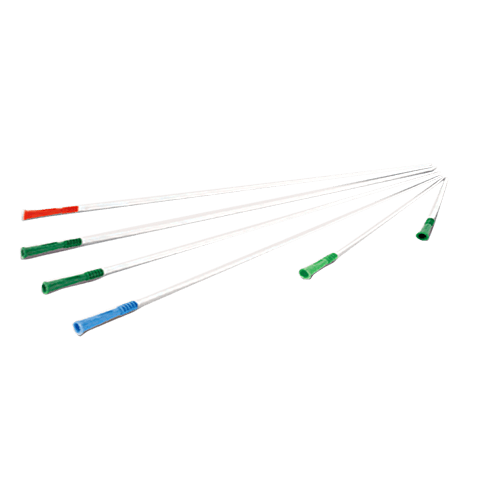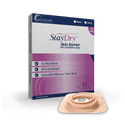- Home›
- Medical Devices›
- Incontinence & Urology Supplies›
- Urology Supplies›
- Intermittent Catheters
Intermittent Catheters
Material
Length
Color-coded Size
Packaging
What are Intermittent Catheters?
Intermittent Catheters are used to empty the bladder for people who have difficulty urinating naturally. Also called nelaton catheters, they are made of medical-grade materials such as PVC or silicone and come in various sizes and lengths. These single-use catheters have smooth, rounded tips for comfortable insertion.
Nelaton catheters are available in different sizes to accommodate the anatomical differences of individuals. The sizing is typically measured by the French scale, which refers to the diameter of the catheter. Common sizes range from 6 French to 24 French, with smaller sizes suitable for pediatric use and larger sizes for adults.
AdvaCare Pharma is a globally recognized manufacturer of Intermittent Catheters, produced in modern facilities in China, India, and the USA, that are certified for ISO and CE compliance. Our urology products are created using high-quality materials and designed to meet the specific needs of healthcare providers and patients worldwide. We maintain strict quality control measures to ensure that our intermittent catheters are safe, dependable, and meet or exceed international standards.
Product Specifications
Features
One-way Intermittent Nelaton Catheter is designed for the short-term drainage of urine. It features a closed rounded tip with two eyes at the end to facilitate atraumatic insertion and efficient urine drainage. This catheter does not have a balloon tip like a Foley catheter, so it cannot remain in situ or in place without assistance. It is made of medical-grade materials and is available in various sizes to suit individual needs.
Why choose us as your Intermittent Catheters manufacturer?
AdvaCare Pharma is a leading manufacturer of Intermittent Catheters and other incontinence and urology devices. We are committed to producing environmentally friendly and highly effective products, which we manufacture intermittent catheters and other urology medical devices in our advanced production facilities located in China, India, and/or the USA.
With over two decades of experience in the healthcare industry, AdvaCare Pharma has developed a strong global distribution network that covers 65 markets. We work closely with our partners and distributors to deliver tailored solutions that meet their unique requirements.
Our goal is to provide our customers with superior medical devices that enhance their quality of life, and we are dedicated to achieving this through innovation, collaboration, and a customer-focused approach.
Uses
How should Intermittent Catheters be used?
To employ an intermittent catheter correctly:
- Begin with meticulous hand washing to minimize infection risk.
- Collect all items for the procedure, such as sterile gloves, antiseptic wipes, and lubricant.
- Carefully remove the catheter from its packaging, touching only the handle to keep the tip sterile.
- Wearing gloves, gently clean the urethral opening with antiseptic.
- Lubricate the catheter tip, then gently insert it into the urethra until urine begins to flow.
- Withdraw the catheter slowly once the flow stops, checking all urine is drained.
What considerations should be made when choosing the size and material of an Intermittent Catheter?
Selecting the right size and material of an intermittent catheter is pivotal for comfort. The catheter diameter should be large enough to allow efficient urine flow without causing discomfort or trauma to the urethra.
Materials like silicone or PVC are chosen based on individual allergy history, sensitivity, and personal preference for flexibility or rigidity.
Some users may prefer the softer feel of silicone, especially if they have experienced urethral discomfort with other materials, while PVC catheters can offer a firmer option for easier insertion.
How should Intermittent Catheters be disposed of?
After use, the catheter should be discarded safely to maintain hygiene and environmental health. Dispose of the used catheter in a medical waste bin or according to local health regulations.
Avoid flushing it down the toilet to prevent blockages and environmental contamination. Wash your hands thoroughly after disposal to prevent the spread of bacteria.
What is the purpose of color-coded sizing for Intermittent Catheters?
Color-coded sizing simplifies the identification process, confirming both the patients, and healthcare providers, select the correct catheter size efficiently. Each diameter size, measured in French, is associated with a unique color.
This system helps to avoid discomfort and complications associated with using a catheter size that is not ideal for the user's anatomy.
Can Intermittent Catheters be reused?
Intermittent catheters are designed for single use to prevent infection and create the highest hygiene standards. Reusing a catheter increases the risk of urinary tract infections (UTIs) and other complications. Always use a new, sterile catheter for each catheterization to maintain urinary health.
How is Intermittent Catheterization used in hospitals?
In hospital settings, intermittent catheterization is a common practice for patients unable to void naturally. Trained healthcare professionals perform the procedure using sterile techniques to guarantee safety and reduce the risk of infection.
This method is favored for its ability to mimic natural urination cycles, thereby encouraging bladder health and preventing complications associated with urinary retention.
How does Intermittent Catheterization contribute to patient comfort?
Intermittent catheterization can substantially lift comfort for individuals with bladder emptying issues. It allows for timely bladder emptying, reducing the risk of discomfort, UTIs, and bladder overdistension.
This method empowers patients to manage their urinary health independently, contributing to a better quality of life.
How is the choice of Intermittent Catheterization technique tailored to individual patient needs?
The selection of an intermittent catheterization technique is customized based on the patient's anatomy, sensitivity, and lifestyle. Factors considered include catheter material preference (e.g., silicone for latex allergies), catheter length (male vs. female), and the size (diameter) suitable for the individual's urethral opening.
This personalized approach leads to successful bladder management while minimizing discomfort and potential complications.
How can patients maintain proper hygiene while using Intermittent Catheters?
Maintaining hygiene involves washing hands and the urethral area before catheterization, using sterile catheters, and proper disposal after use.
Patients should follow guidelines for cleaning the insertion area and avoid touching the catheter tip to maintain sterility. Regular hygiene practices reduce the risk of UTIs and assure a safe catheterization process.
What are the benefits of personalized Intermittent Catheterization training from healthcare providers?
Personalized training sessions from healthcare providers make sure that patients receive instruction that is tailored to their unique anatomical and health-related needs. This individualized approach addresses specific challenges and concerns, making the learning process more robust.
Through hands-on demonstrations and the opportunity to ask questions, patients gain confidence in their ability to perform intermittent catheterization safely and efficiently. This personalized guidance is influential in minimizing anxiety, better technique accuracy, and nurturing a positive catheterization experience.
How does the strategic use of Intermittent Catheterization advance bladder health and patient independence?
Strategic use of intermittent catheterization contributes to bladder health by preventing overdistension, lowering the risk of urinary tract infections, and maintaining kidney function.
For many patients, this method increases independence and assurance in managing their bladder dysfunction. It allows individuals to participate more fully in daily activities and reduces the need for caregiver assistance for bladder management.
FAQs
How does an Intermittent Catheter work?
An intermittent catheter is a medical device used to drain urine from the bladder. It is a flexible tube inserted through the urethra into the bladder, allowing the urine to flow out. Once the bladder is emptied, the catheter is removed.
What is the purpose of color-coded sizing for Intermittent Catheters?
Color-coded sizing is used to help individuals and healthcare professionals identify the appropriate size of the intermittent catheter. Each catheter size is assigned a specific color, making it easier to select the right catheter for individual needs. This system simplifies the catheterization process and reduces the risk of using the incorrect size.
How often should Intermittent Catheters be changed?
The frequency of changing intermittent catheters depends on various factors, including the individual's needs, the presence of urinary tract infections, and the healthcare professional's recommendation. In general, intermittent catheters are often used once and then disposed of, reducing the risk of contamination and infections. Follow the specific guidelines provided by healthcare professionals to maintain proper hygiene and prevent complications.
What are the advantages of using Intermittent Catheters over other types of catheters?
Intermittent catheterization offers several advantages, including reduced risk of UTIs and other complications, improved bladder function and urinary continence, enhanced mobility and independence, and greater comfort and discretion for patients. It allows for more natural bladder emptying while minimizing the need for continuous catheterization or invasive procedures.
How do distributors select the most suitable option for Intermittent Catheters?
Intermittent catheters, which come in various types, lengths, diameters, and materials, are designed to accommodate different patient preferences and anatomical considerations. Medical distributors should conduct market research to evaluate the most suitable specifications based on factors such as gender, age, level of mobility, urethral size and personal comfort of the target demographic.
Do your Intermittent Catheters adhere to international regulatory protocols?
Our medical devices are specifically developed to align with worldwide regulatory requirements, including CE, ISO, and USFDA certifications, to deliver unparalleled safety and efficacy across the globe.
References
Intermittent catheterisation with hydrophilic and non-hydrophilic urinary catheters: systematic literature review and meta-analyses
This study is a systematic literature review and meta-analysis that compares the use of hydrophilic and non-hydrophilic catheters in intermittent catheterization. The results showed that hydrophilic catheters are associated with a lower risk of urinary tract infections (UTIs) compared to standard catheters.
A Real-world Data Analysis of Intermittent Catheterization, Showing the Impact of Prelubricated Versus Hydrophilic Catheter Use on the Occurrence of Symptoms Suggestive of Urinary Tract Infections
This study is a real-world data analysis that compares the use of prelubricated and hydrophilic catheters in intermittent catheterization. The results showed that both types of catheters have a similar safety profile, but coated catheters (prelubricated or hydrophilic) appear to be the best option for safe, long-term intermittent catheterization.
Understanding the properties of intermittent catheters to inform future development
This study aims to understand the properties of intermittent catheters to inform clinical practice. The results showed that long-term intermittent catheterization is associated with a decrease in complications such as prostatitis, the incidence of urinary stones, and UTIs.
Scientific Review of Intermittent vs Indwelling Catheterisation
This study is a scientific review that compares intermittent catheterization to indwelling catheterization. The results showed that intermittent catheterization is a safer bladder management option and can lead to reduced morbidity relating to renal failure and neurogenic bladder. Intermittent catheters are also reported to reduce the risk of infections as compared to indwelling catheters.
You might be interested in...
Why AdvaCare Pharma?
As an industry leader, we are aware of our responsibility to provide affordable and sustainable solutions to improve healthcare worldwide.













